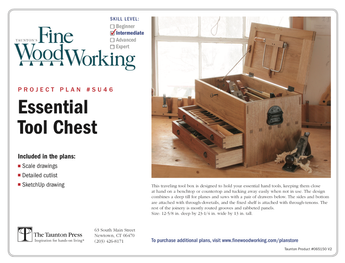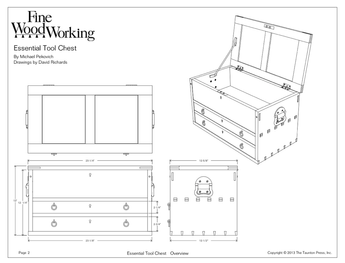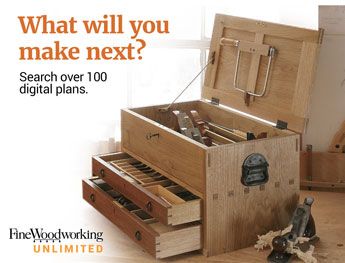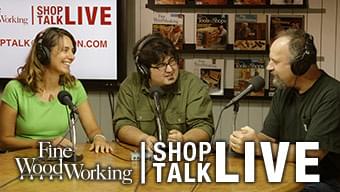I have a 36″ American Mach. Corp. bandsaw. Circa 1915.
I need to replace the electric motor . I was hoping someone might give me some advice regarding the size and specificationsthat are needed. There is a heavy cast iron 25″ flywheel on the back (double pully) I have only single phase power.
The existing old Baldor motor is no help, info plate is gone.
I’m sure I need at least 5 hp, but what speed, and what size pully on the motor shaft?
Also what blade speed is desired on a saw this big? Slower I would think.
Any thoughts???
Thanks
-eli













Replies
The double pulley was used to take power off a lineshaft in factories past. There'll be one that spins free and one that is locked to the shaft.
The real center of the universe for machines like this is the Old Woodworking Machines forum:
http://www.owwm.org/
Pete
Edited 10/3/2006 10:45 pm ET by PeteBradley
I worked in a planing mill and we had a 42" bandsaw. The blade traveled at about 10,000 fpm
Take a look at http://www.northfieldwoodworking.com/bandsaws/36deluxe.htm
Thoughts? Yes- heavy old machines can be well worth the effort of re-building if you have the skills.
Blade speed? If it were mine and for use only on wood I would run the blade at a medium speed i.e about 1500feet per minute. That means a 36 inch diameter wheel must turn at 160 revs per minute,which is slow, meaning that you will need a counter shaft to end up with the required output speed, or you can use a reduction gear box. Counter shafts are nice because they enable a range of speeds.
Horse power? I have a 30inch diameter old beast, with a 3 horse motor (old British so genuine horses): this is plenty of power even for 12 inch cuts in hard woods, but it depends also on what blades you run.Also, since you are gearing down a lot you have mechanical advantage.
What is the problem with the Baldor motor? Take it to a motor rewinding shop or an electrician and it can be tested and the horse power established-you might get lucky.
Having only single phase is a distinct disadvantage in your case, unfortunately.
I attach a pic of mine for your interest: the machine is German .
Beautiful piece of machinery, might I beg you again for some more pictures of your shop?
Since the house is on fire let us warm ourselves. ~Italian Proverb
There you go Don-I just selected some pics from Picasa. The shop is 10 metres x 20 metres. At times it can look like a coal mine-or a museum for old machines.I have another area with timber racks and a spray booth of sorts.Come to think of it , there are some items that have not been photographed, such as my Griggio 8 foot jointeretc.
Pics 040 and 043 show my smaller bandsaw with a counter shaft and also a gearbox, giving me a range of speeds to cut wood, non ferous and steels-the gearbox gives a slow enough fpm for steel cutting.
Philip MarcouEdited 10/4/2006 3:32 am by philip
Edited 10/4/2006 3:32 am by philip
Thank you very much, I took a quick look and will now go digest them more thoroughly. How do you like the sliding table shaper? Am going now for a towel to wipe the drool . Do you mind some questions?
Since the house is on fire let us warm ourselves. ~Italian Proverb
Edited 10/4/2006 3:35 am by dgreen
Ask away....
The sliding table on a shaper is a very good thing-makes for more versatility and safer use.I cut tenons with that after cutting mortices on a hollow square machine.
I added an extra pair of rollers for the sliding table so that I could use it for a planer knife grinder-I attach some pics-works well.Philip Marcou
Philip;Amidst all that power, is that a spinning wheel? Please tell me you aren't making your own steel wool.AndySaid least is often said best,
but said best is often said least.
Andy- yes indeed it is a spinning wheel. I made it long ago, by copying an antique Dutch one belonging to a friend, and gave it to my Mother. In fact it was one of the first things I made when my Father gave me a Black & Decker drill driven lathe . I made my turning chisels from files and still use them today.The wood for the spinning wheel is Jacaranda, from my own property then.Philip Marcou
Edited 10/5/2006 8:56 pm by philip
Thanks Phillip,1500 fpm seems so slow. Perhaps it makes sense for such a big machine. 14" saws run at 2500-3300. Do you know what speed your 30" runs at? Oh and is that a left handed machine, or am I looking at it wrong? Tomorrow perhaps I can take a pic of mine and post it.Thanks, -EliBrookfield Woodworking
Cushing, Maine
Eli, I was wandering why I had not asked you for a picture of your machine...
Re band speeds: whenever I have built or modified bandsaws I have answered questions such as speed by looking at blade manufacturer specs, machine manuals/info on doors , books and my own experimenting.
Regarding my own machine(the bigger one)it is running at 1500feetperminute and I like the results, meaning that this speed suits all the blades I use and it seems to be efficient enough. When I first set it up I ran it a bit faster, but there was vibration -possibly wheels out of balance, but at the present speed it is plenty smooth.
I have just looked at M Duginske's Bandsaw book and see that he rates a slow speed to be 800fpm, a medium speed to be 1800 fpm and fast to be 2700fpm- so there is a wide range.
Ofcourse it depends upon the type of blade and the materials to be cut, so I suggested 1500 fpm for wood for your machine as an average.
Ideally one would like to have a variable speed motor or gearbox idf one has a quality saw and there is need to cut a diverse range of materials....If that saw you have is what I think it is then one opf these would be the icing on the cake.
I suppose my saw is "left hand", but there is the option to place the table the other way-it never bothered me. My smaller machine is "right hand".
I look forward to seeing your saw fired up...Philip Marcou
Hey all I am having no luck uploading a picture of my saw to this post. Are there any special instructions for mac users? I press upload and nothing happens....?ThanksBrookfield Woodworking
Cushing, Maine
Hello,
I've got a similar saw that I got about a year ago. I set mine up with a 3 horse single phase motor. I thought that i'd need a five horse, but I got a really good deal on this one, so I thought I'd give it a try. Well so far it's been absolutely plenty, and I've cut some very heavy oak and locust and been happy with it. The only complaint I have is that if I were to do it again, I'd get a 1725 rpm motor, and not a 3250, but that's what was available. As it is, I've got a 2.5 inch sheave on the motor and a 24" on the saw, which means that the blade is going if I recall correctly, about 4000 fpm. It seems a bit fast, but works fine. When I set this up, I looked around to see what kind of speed I should shoot for, and this worked out to be on the high side of average, so I'm surprised to see that others are suggesting 1500. I may set it up with an intermediate shaft to drop the speed down, but I seem to always think of something I'd rather do. By the way, I'm about 20-25 minutes away from you in Warren. If you'd like to see how I've got mine set up, let me know. What do you work on down there in Cushin'?Mike
Thanks for the info .I have been trying to post pictures of my saw with no luck, I don't know what I'm doing wrong. Right now I have the saw all painted and reasembled. Looks like I'll order a 1725 / 3hp motor as a result of yours and also "phillips" advice.Down here in Cushin' I'm building a boat!Thanks again. Send me your email and I'll send you a pic directly.Eli Ellis
[email protected]
354-0161
Brookfield Woodworking
Cushing, Maine
Philip, we assume that the white box is a speed control for sharpening blades or anything else? The previous pics of the EMCO set up provide me with enough tears to wash away DG's drool having being a machinist mate on submarines who lived with a 9" South Bend with a milling attachment (as a space constraint) and were to be able to make ANY part that the boat needed. Please under stand that some of us are amatuers, but we still enjoy the site of such a fine shop. Many thanks for the pics. Pat
edit ps. BTW it looked to me that you had a male and female HAGGIS on the top shelf over the EMCO unit, is that legal? pfh
Edited 10/5/2006 8:20 pm ET by PADDYDAHAT
Paddy,
One of the haggisses is in fact the bristle end of a shaving brush-on the second shelf is the back end of one. These were army issue long ago and I accumulated quite a number, having found other uses for them....
I think the other item in question was a rag-it seems to have gone now.
Yeah, I love my SouthBend 9 inch- white metal bearings smooth as glass and no chatters.Definitely a good way to utilise space on a submarine.
The white box on the planer knife grinder is merely a (legal) convenient way to have a switch and portable electrical connection-it being a three phase motor.Philip Marcou
Phillip, I am agast as I should have recoginised Ms. haggis . The atomosphere in a nuclear sub is a sensitive thing that prohibits the use of aerosol shaving creams (as well as many other nice to have things) due to the propelant in the can. I shaved and I must say very well for many years using a brush and mug well after I left the "boats". Mine were pure badger and have been revered for their performance. I bought them all over the MED and may revert back to them given the poor performance of the modern aerosols (with their special aromas and no performance). Many thanks for the reply, you give us joy, Pat
Thanks for all the info!I can't post pics to this site...???Send me your email address and I will send you a pic directly.Eli Ellis[email protected]Brookfield Woodworking
Cushing, Maine
You can look up comparable specs on similar machines and a little math will give you rpm, SFPM, etc.
A motor shop can get the specs on your motor!
Rotary phase converters, static converters, VFD's and Phase Perfect will give three phase in anyones home.
1915 surely means babbit bearings which is really no problem. Quieter than ball bearings and still a servicable option.
Actually this bandsaw has been coverted to ball bearings, they did a beautiful job of it too!!Brookfield Woodworking
Cushing, Maine
I Have a 32" Cresent Band Saw w Babit Bearings. It Has a 5 Hp Motor that is 1750 RPM. The Pully on the Motor is 3 1/2" O.D. , the Pully on the Shaft is 13" O.D. . I Hope this Helps. My Shop Runs on a Phase Converter , It's Great. You May Want to Invest in One, because most of Your Large Older Equiptment is Going to be 3 Phase.
I have an old Defiance 36" that I replaced the 5 HP motor with a 7.5 HP, and really like the change. Mine is running a lot faster than most though at 5588 fpm it is what would be referred to as a high-speed BS.
At this rpm, the power is about right for that speed. I think that if you are going to stay with the 5 HP, I would suggest that you keep them below 4000 fpm. depending on how you plan to use it.
Tannowitz standard motor size for the 36" is 10 hp. but their maximum height of cut is 22" under the top guide, and mine is only 16". Using these numbers, I like to think of sizing the motor for one hp for each 2" of thickness at these speeds. However, you can get the power needed to keep from bogging the motor down by slowing the fpm. You will just be getting a slower feed rate.
If you use a 1725 rpm motor, and a 5" motor pulley with that 25", you should get about 3250 fpm., and a 4" on the motor would give you 2600. I would be inclined to go with the 5" if it were mine and limited to the 5 hp.
1HP per 2in of cut is really overkill on a narrow bandsaw - my 28in Aggy (about 17in under guides) would need 34HP on your formula - with a 1-1/4in 2/3tpi vari-pitch Lenox Trimaster it cuts 14in pitch pine or 12in beech as fast as I can feed it (with a power feeder) on just 4HP. Many of the older machines had only 3 to 5 HP for a 30in or 36in saw because they simply weren't expected to handle more than a 1-1/4in blade - it's only the wide resaws with 4in or wider blades and high speed feeders which need huge amounts of power, but then their feed rates and the blade friction are in a whole different league.
Scrit
Scrit, when I bought this old saw, it had a 5 hp motor, and on cold mornings, when the grease was stiff, it had a hard time getting started, and there were some times when I would be cutting out big turning blanks that I would come close to bogging the motor down, so I know that the 7.5 is not over-powering this saw. Here is a link to a site if you don't think I know what I am talking about, why would these people bother with making 10 hp their standard size?http://www.max-ind.com/m_catalog2.asp
Forgive me Keith, but my experience is based on running an Aggy 28in with a power feeder for resawing mainly hardwoods used in my woodworking business. It's a modern saw with sealed bearings and doesn't need the 2HP per inch of cut depth and I know of no manufactured narrow bandsaw which requires than much power. Even my previous saw - a Thomas White 36in solid cast iron machine required no more than 5HP on a 1in wide blade for 12in deep cuts. But I'm tending to saw temperate hardwoods as opposed to extremely dense tropicals and I'm not curve cutting which tends to use more power. I do use carbide or stellite tipped blades on resawing and I'm running at quite a high blade speed.
You mention starting difficulties, but a modern motor starting a heavy cast-iron wheel band saw is operating near its theoretical maximum loading at startup (even more so if single-phase) so I've found that either a Star-Delta starter is required, even if your motor is only 4 HP or so (and most medium to large European industrial bandsaws have Star-Delta), whilst VFD (variable frequency drives) are even better for starting heavy machinery under load - but I'm talking three phase industrial as same rated single phase motors seem to produce much less torque. If you are running on single phase you are at an immediate disadvantage because your current draw at startup will be much higher on some of the older machines. Once it's running, however, the inertia of the iron/steel wheels helps to keep the thing turning smoothly and relatively little extra power input seems to be required. We used an ammeter to try to prove or disprove this on the Aggy a while back, and the conclusion we reached was that the biggest limiting factors to resawing performance were dull blades and lack of dust extraction - both of these caused the ammeter needle to rise noticeably.
BTW the best way I've found to overcome inertia in even tired old motors is to fit a VFD for starting - puts less strain on the motor than even Star-Delta.
Scrit
Scrit, Thanks for your insights. Perhaps my saw is running at too high a speed at the expense of torque. But oh well, I am happy with it the way it is now.I have a woodmizer LT 15 sawmill out on the parking lot, so I don't need mine for re-sawing. Since you and I have not to my recollection had an introduction. It is good to hear your thoughts, and I would like to add that I do have 600 amp 3 phase service to my shop, which was an old grocery store, so I am not short on power here.
Thanks to everyone!!I have just posted pictures of my saw at owwm.com.
Serch the Photo Index for : American Wood Working Machinery Co.
Mine is the 36" Band Saw posted on 10/10/06Thanks,
EliBrookfield Woodworking
Cushing, Maine
Yes Eli, I have just feasted my eyes upon this fine machine.Definitely worth extending yourself to get a suitable motor and drive set up, even if you do not have three phase there are alternatives (even in America).
I would also consider fitting tires or some sort of protection to blade and wheel to the wheels. I used a nylon conveyor belting on mine which I glued on and this means you can run very narrow blades with the teeth riding on the cushioning belting without loseing set. I used to concern myself about setting the blade to run so that the teeth were overhanging, but no longer bother.
If there is no cover for the upper wheel it would be advsisable to make up one, plus a sliding guard for the blade above the table.Philip MarcouEdited 10/10/2006 9:03 pm by philip
P.S and have just seen your e mail. I see the cups-these appear to be grease cups rather than oil cups. Strange-it does not look to me as if it were ever with white metal bearings, judging by the size and shape of the axle hosings. Anyway, leave them there and you can then remove the inner seals from each bearing (leaving the outer seals) and fill with grease-will then last for ever.
Edited 10/10/2006 9:11 pm by philip
Phillip,You write " Strange-it does not look to me as if it were ever with white metal bearings, judging by the size and shape of the axle hosings." Are you saying that this machine could have had ball bearings originally? I was told that this is a 1915 saw. Would it have been manufactured with ball bearings in 1915? I should say that it is totally possible that 1915 is the wrong year. I could have recieved wrong info...? Thanks
EliBrookfield Woodworking
Cushing, Maine
Eli, certainly ball bearings were in use in 1915.As to what the machine was fitted with originally, I don't know. Looking at that lower shaft housing it was made to take ball bearings-see the enlarged end and flange cover to house the bearing.It could also be that this was all fitted later as a complete bolt on unit . Usually the housings for white metal bearings are slim castings split along length, the two halves being bolted together and the diameter of such a unit would not be that much greater than the actual shaft, since all that was needed was the thickness of the white metal plus adequate casting thickness.There is bound to be some body at OWWM who can provide facts-is the maufacturer still around?
You can get help on your picture posting problem from the admin at Fww Knots- Matt Burger is the name, but I forget how to get him....Philip Marcou
This forum post is now archived. Commenting has been disabled